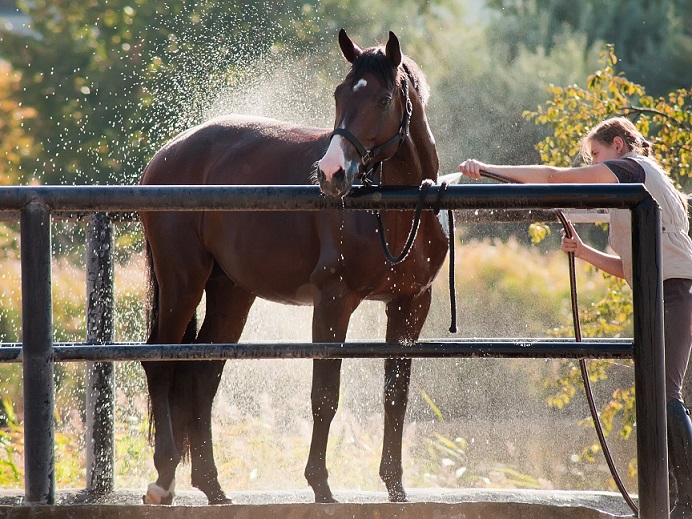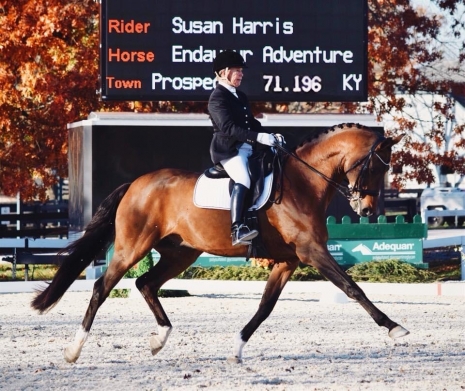
By Sue Weakley in consultation with Kimberly D. Snyder, DVM, PA
It’s hot out there! Summer heat can be dangerous for horses and could lead to dehydration, muscle cramps, respiratory distress, diarrhea, or even colic. And every horse is at risk. It’s important to monitor your horse to watch out for heat-related problems. Here are 10 hot weather tips to help your horses chill out in the summertime sun.
1. Nighttime is the right time. If possible, turn your horse out at night or early in the morning to take advantage of naturally cooler temperatures. Riding during these cooler hours is also recommended.
2. It’s cool to be shady. If you do turn out during the day, provide relief from the sun’s direct rays. If you count on trees for shade, make sure that as the sun moves, there is still shade available.
3. I like to move it move it! Fans are a great way to provide a cooling breeze but make sure that cords are safely out of reach. Consider trying misting fans as they can decrease the air temperature by 10 degrees.
4. Be your horse’s water boy. Water in a bucket can get hot and stagnant fast and algae can grow quickly in the heat. A 1,000 pound horse can drink 20-25 gallons of water a day so check on buckets, stock tanks and troughs to make sure your horse has plenty of cool, clear, fresh water.
As pasture quality diminishes during the summer, don’t forget to monitor and provide a nutritional source of fodder for your horse along with lots of fresh water.
5. Salt of the Earth. Dehydration from sweat loss is a major danger so it’s important to provide salt to help keep things balanced, and many electrolytes do not provide enough of the elements lost in sweat (sodium, chloride and potassium) as salt does. Horses have a normal baseline requirement of salt of about one ounce a day—without sweating. Some vets suggest adding salt directly to meals. Equine veterinarian Kimberly D. Snyder, DVM, of Wellington, Florida, said she often prescribes a daily sprinkling of a teaspoon of Morton® Lite Salt™ to feed to add potassium and chloride to the diet, especially for a horse that’s not drinking enough water on his own. “Free choice salt with trace minerals is also recommended,” she said. Himalayan salt is a popular choice.
6. Don’t sweat it. If your horse sweats a lot, adding electrolytes in feed or water in addition to providing salt can help keep a horse’s body in balance. Rely on your veterinarian to suggest an electrolyte tailored to your horse’s unique needs. But, as always, too much of a good thing can be harmful, so be sure and follow your vet’s recommendations and offer plenty of plain, cool, fresh water as well as electrolytes.
7. Work it! If your horse is ridden infrequently, now is not the time to get him into shape. Even a well-conditioned horse can become stressed if the heat index is high. Be sure and offer plenty of water after a workout. It’s a myth that it’s dangerous to let your horse drink when he's hot. A hot horse will drink from two to five gallons of water. If your horse is breathing heavily after a workout, let him take a few sips of water, walk him for a minute and let him have another drink, but if you restrict intake, he may lose the drive to drink and will consume less water.
8. Cool it. Hose off or sponge your horse for a quick cool off, especially on the large blood vessels under the belly, neck and legs. Target your horse’s chest, poll and behind the hind limbs. Body heat is quickly transferred to the water. Be sure and scrape off excess water immediately, especially in humid conditions.
Some riders swear by the sponge and scrape method. Sponge and scrape, sponge and scrape, sponge and scrape until the water being scraped off is no longer hot.
Top-level endurance riders and eventers douse their horses down with ice-cold water after they finish a ride to bring the body temp down quickly. But, a cool shower is more comfortable than a cold shower, so unless you are headed to a vet check, cool water will feel better to your horse.
9. Sweat is Sweet! Anhidrosis is the inability to sweat normally. When your horse doesn’t sweat, his natural ability to cool himself off is diminished. According to Dr. Kim Snyder, indicators that your horse may be having trouble self-regulating his body temperature are as follows:
- Increased respiratory rate while your horse is at rest
- Elevated body temperature while your horse is at rest (102-103+°F)
- Inability to cool down post exercise
- Labored breathing or blowing hard
“These critical signs may or may not be associated with other disease processes, so it’s important to contact your vet,” Snyder said. “The inability to sweat can not only lead to elevated body temperature, but it can also lead to complete organ failure and death.”
10. Check it out. Watch your horse for signs of heat exhaustion: weakness, stumbling, increased respiration (40-50 breaths a minute and shallow breathing), increased heart rate (more than 80 beats a minute even after two minutes of rest), and an elevated temperature (102+ degrees F). With heat stroke, symptoms are more severe and body temps will remain above 106 degrees F with a cessation of sweating. If you suspect heat exhaustion or heat stoke, it’s time to call the vet.
Bottom line? Lots of water for the inside and outside of your horse while making sure not to work him beyond his fitness level and careful monitoring will help you avoid the dangers of hot weather for your horse.






 Latest Horses for Sale and Lease
Latest Horses for Sale and Lease
